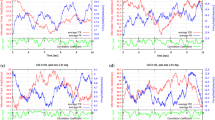Summary
-
1.
The two C cells and the single S cell in each segmental ganglion of the leech nerve cord are strongly electrically coupled, as are the S cells of adjacent ganglia. Impulses arising in any of these neurons propagate rapidly, via the fast conducting system formed by the axons of the S cells, to all other neurons in the network.
-
2.
The dye Lucifer Yellow crosses the electrical junctions among the C and S cells. Exploiting this property of the dye, I traced the fast conducting system rostrally into the subesophageal ganglion, and caudally into the tail-brain.
-
3.
The dye revealed 9 previously unidentified neurons in the subesophageal ganglion: 2 neurons resembling C cells in each subganglion, and a single asymmetrical neuron, designated S0, in the most anterior subganglion.
-
4.
Physiologically, the S0 cell resembles the S cells of the segmental ganglia, and it may be homologous to them despite its unusual structure.
-
5.
Strong electrical coupling (coefficient 40%) between the S0 cell and the S1 cell (the S cell in the first segmental ganglion) ensures that an impulse in one neuron is always matched by an impulse in the other.
-
6.
Input from tactile and photic receptors on the head excites the S0 and S1 cells, eliciting impulses from initiation sites in the processes of the S1 cell, within the subesophageal ganglion.
-
7.
Lucifer Yellow revealed 21 previously unidentified neurons in the tail-brain; these evidently consist of an S cell and 2 C cells in each subganglion.
-
8.
A recently-proposed model for the origin of the unpaired neurons of the leech nervous system explains the asymmetry of the S0 cell.
Similar content being viewed by others
References
Blair SB (1983) Blastomere ablation and the developmental origin of identified monoamine-containing neurons in the leech. Dev Biol 95:65–72
Fernandez J, Stent GS (1982) Embryonic development of the hirudinid leechHirudo medicinalis: structure, development and segmentation of the germinal plate. J Embryol Exp Morphol 72:71–96
Frank E, Jansen JKS, Rinvik E (1975) A multisomatic axon in the central nervous system of the leech. J Comp Neurol 159:1–13
Gardner-Medwin AR, Jansen JKS, Taxt T (1973) The ‘giant’ axon of the leech. Acta Physiol Scand 87:30A-31A
Kramer AP (1981) The nervous system of the glossiphoniid leechHaementeria ghilianii. II. Synaptic pathways controlling body wall shortening. J Comp Physiol 144:449–457
Kretz JR, Stent GS, Kristan WB Jr (1976) Photosensory input pathways in the medicinal leech. J Comp Physiol 106: 1–37
Laverack MS (1969) Mechanoreceptors, photoreceptors and rapid conduction pathways in the leechHirudo medicinalis. J Exp Biol 50:129–140
Magni F, Pellegrino M (1978a) Neural mechanisms underlying the segmental and generalized cord shortening reflexes in the leech. J Comp Physiol 124:339–351
Magni F, Pellegrino M (1978b) Patterns of activity and the effects of activation of the fast conducting system on the behavior of unrestrained leeches. J Exp Biol 76:123–135
Miller JP, Selverston AI (1979) Rapid killing of single neurons by irradiation of intracellularly injected dye. Science 206:702–704
Muller KJ, Carbonetto ST (1979) The morphological and physiological properties of a regenerating synapse in the C.N.S. of the leech. J Comp Neurol 185:485–516
Muller KJ, McMahon UJ (1976) The shapes of sensory and motor neurons and the distribution of their synapses in ganglia of the leech: a study using intracellular injection of horseradish peroxidase. Proc R Soc Lond B 194:381–499
Muller KJ, Scott SA (1981) Transmission at a ‘direct’ electrical connexion mediated by an interneuron in the leech. J Physiol (London) 311:565–583
Muller KJ, Nicholls J, Stent GS (1981) The neurobiology of the leech. Cold Spring Harbor Laboratory, Cold Spring Harbor, NY
Nicholls JG, Baylor DA (1968) Specific modalities and receptive fields of sensory neurons in the CNS of the leech. J Neurophysiol 31:740–756
Peterson EL (1983) Visual processing in the central nervous system of the leech. Nature 303:240–242
Rohde E (1892) Untersuchungen über das Nervensystem der Hirudineen. Zool Beitr (Berlin) 3:1–69
Stewart W (1978) Intracellular marking of neurons with a highly fluorescent naphthalimide dye. Cell 14:741–747
Weeks JC (1982) Segmental specialization of a leech swim-initiating interneuron. J Neurosci 2:972–985
Yau K-W (1976) Physiological properties and receptive fields of mechanosensory neurons in the head ganglion of the leech: comparison with homologous cells in segmental ganglia. J Physiol (London) 263:489–512
Author information
Authors and Affiliations
Rights and permissions
About this article
Cite this article
Peterson, E.L. The fast conducting system of the leech: a network of 93 dye-coupled interneurons. J. Comp. Physiol. 154, 781–788 (1984). https://doi.org/10.1007/BF00610678
Accepted:
Issue Date:
DOI: https://doi.org/10.1007/BF00610678




